 This is the fourth installment of the Evacuation Preparedness Kit Series. The first post, on Evac Prep Basics is here, and the second post, which introduces the Evac Prep Master List is here. The third post, and the first post on the list review is here. This post will pick up where we previously left off in reviewing the categories on the Master List.
This is the fourth installment of the Evacuation Preparedness Kit Series. The first post, on Evac Prep Basics is here, and the second post, which introduces the Evac Prep Master List is here. The third post, and the first post on the list review is here. This post will pick up where we previously left off in reviewing the categories on the Master List.
Clothing
 This is another highly personal selection category. The main thing to consider is that you have NO idea what type of situation you’re preparing for. I suggest packing two separate crates for clothing. The first should be regular/warm weather clothes with the second containing winter clothes. This way you won’t have to carry or dig through all the winter clothes unnecessarily.
This is another highly personal selection category. The main thing to consider is that you have NO idea what type of situation you’re preparing for. I suggest packing two separate crates for clothing. The first should be regular/warm weather clothes with the second containing winter clothes. This way you won’t have to carry or dig through all the winter clothes unnecessarily.
Consider that during an evacuation you will likely be outside a lot, be doing much manual labor, could be schlepping through the woods, and may be doing industrial type cleanup. You will want to have good sturdy clothes with you! Also consider and prepare for different inclement weather. It could be rainy, windy, sweltering hot, or freezing cold.
Also take your footwear into serious consideration. You’ll need sturdy boots for clean-up and hiking and tennis shoes for around camp to give your feet a break from the boots. You’ll also want to make sure you can keep your feet dry as much as possible. I never met a camper who thought they had too many socks!
Cleaning Clothes
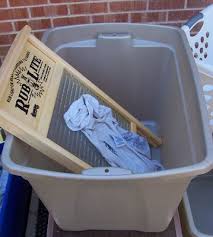 You’ll also want to make sure you have a method for washing out your clothes – especially if you end up outside a lot or doing disaster clean-up. This is another area that you’ll want to pay careful attention to and make sure you Know Before You Go how to wash your clothes! There are several techniques for doing this including using a scrub/washboard for cleaning hard dirt/stains, a plunger washer (plunger, 5 gallon bucket, water, laundry soap) for cleaning/rinsing and a clothes line and clothes pins for drying.
You’ll also want to make sure you have a method for washing out your clothes – especially if you end up outside a lot or doing disaster clean-up. This is another area that you’ll want to pay careful attention to and make sure you Know Before You Go how to wash your clothes! There are several techniques for doing this including using a scrub/washboard for cleaning hard dirt/stains, a plunger washer (plunger, 5 gallon bucket, water, laundry soap) for cleaning/rinsing and a clothes line and clothes pins for drying.
Bug Out and EDC Clothes
 In a bug out situation, you can’t assume that you will have suitable clothes on when you bug out. You should have at least 2, preferably more, changes of clothes in your BOB. You’ll want to add and remove winter clothing considerations as the seasons change. Gloves are always a critical component of a good BOB.
In a bug out situation, you can’t assume that you will have suitable clothes on when you bug out. You should have at least 2, preferably more, changes of clothes in your BOB. You’ll want to add and remove winter clothing considerations as the seasons change. Gloves are always a critical component of a good BOB.
For EDC consideration, many serious preppers wouldn’t be caught wearing clothes that weren’t suitable for survival. I personally only wear cargo or BDU style pants (in nice business dress colors), shirts which can conceal a firearm, sturdy boots and carry gloves and a beanie in my EDC bag. Serious preppers are Ready for Anything Day in and Day out. If this isn’t describing you, you may want to consider whether your accustomed daily attire is very fitting for an emergency situation and assess whether you want/need to make any changes.
Fuel
There are many, many techniques and tools for starting and maintaining fire – and to survive you MUST have this ability for heating yourself, cooking food and generating light. I have been working on a post that covers many areas of fire starting, look for it soon. Here, we will just briefly touch on several ways to start fire (create a flame) that you may include in your evacuation kit – remember, redundancy is your friend:
- BlastMatch
or similar magnesium/flint combination
- Matches (waterproof)
- Lighter
- Magnifying Glass
- Steel Wool/9 volt battery
The type of fuel you pack in your Evacuation Kit will depend on what type of stove you have. Make sure that you pack enough fuel to cook and heat for several days. You may also be using battery powered light sources – if so you may consider stocking rechargeable batteries, a solar battery charger and solar panels. We’ll have a post soon on this particular topic as well.
Fuel and EDC/BOB
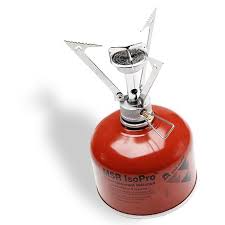 Whereas in your Evacuation Kit you can pack a lot of fuel, your BOB and EDC kits will have much less to none. For your Bug Out Bag, I suggest getting a compact backpacking stove and keeping the stove and one can of fuel in your BOB. I also keep a Blast Match (pictured above), 2 lighters, matches and a flint/steel set in my BOB.
Whereas in your Evacuation Kit you can pack a lot of fuel, your BOB and EDC kits will have much less to none. For your Bug Out Bag, I suggest getting a compact backpacking stove and keeping the stove and one can of fuel in your BOB. I also keep a Blast Match (pictured above), 2 lighters, matches and a flint/steel set in my BOB.
For EDC, I keep a BlastMatch and a lighter in my EDC Bag. If you’re on the run with only your EDC and you need to cook or need heat, a fire is probably your best bet. It would be wise to obtain the training and experience needed to be able to survive with just a fire.
Food Prep/Eating/Cleanup
 I strongly recommend that you buy or build a good Chuck Box to keep all of your camping kitchen supplies in. I will be following this series up with a full pictorial post and plans on how to build your own Chuck Box. Not only does it serve to hold all your kitchen gear for your Evac Kit, but it helps keep it clean, organized and accessible. Camping kitchen gear is famous for being lost, filthy or broken.
I strongly recommend that you buy or build a good Chuck Box to keep all of your camping kitchen supplies in. I will be following this series up with a full pictorial post and plans on how to build your own Chuck Box. Not only does it serve to hold all your kitchen gear for your Evac Kit, but it helps keep it clean, organized and accessible. Camping kitchen gear is famous for being lost, filthy or broken.
From experience, I suggest you pack more silverware and dishes than you think you need (not just one per person). Make sure that you have a wash and a rinse basin along with sponges, a scouring pad and dish soap. For you Evac Kit I would pack everything on our Master List for the kitchen.
BOB/EDC Food Preps


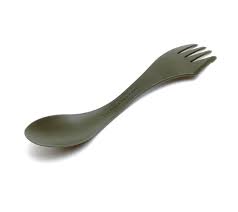
In your BOB you’ll want to pack a compact cooking set – the most important things are a pan to boil water in and a frying type pan. With those two pans you can cook almost anything over a fire. A wide metal plate, deep metal bowl, a metal mug and a spork type utensil are, in my experience, the best personal outdoor eating gear. Mostly because they don’t take up much room, you can pack stuff inside them easily and when using them, you can put them over the fire to heat or boil their contents. I keep a scouring pad with them as well for quick and easy cleaning.
For EDC, a spork and the previously mentioned Hydration Bladder and Straw Filter
along with the assumed Pocket Knife will allow you to eat (it may not be the most convienent way to eat, but it’s convienent to carry). Survival and Foraging skills will help you learn good methods for eathing without containers.
Books
 The list has only a few books listed. A proper emergency and survival book list would have to be it’s own never-ending list. I’ve attempted to put some examples of categories of books that you might find useful in your Evacuation Kit, you’ll need to choose your favorites that you’ll want as both a reference and as reading material to pass potentially boring time.
The list has only a few books listed. A proper emergency and survival book list would have to be it’s own never-ending list. I’ve attempted to put some examples of categories of books that you might find useful in your Evacuation Kit, you’ll need to choose your favorites that you’ll want as both a reference and as reading material to pass potentially boring time.
I will say however that, if you’re religious, having your scriptures with you can help calm things and provide you with fine reading while you wait out the emergency. I personally carry a very small set of scriptures in my EDC bag.
Personal Items
 Some quick comments about this category:
Some quick comments about this category:
- Toilet paper is something you really don’t want to be without. Pack what you think you’re going to need, then add a roll or two. Keep a roll in your BOB and at least some in your EDC.
- Tampons have their obvious uses, but they also make a great blood absorber. If you’re in a situation where there’s a heavily bleeding wound, you can stuff a tampon in there to clot it off.
- Extra Glasses – if you missed it, here’s our post about getting quality, inexpensive glasses online.
- Contacts – if you wear contacts and if you don’t have a spare pair in your kit, make sure you put a spare contact case and some saline in there. Chances are you’ll be wearing them when you bug out and will need to take them out.
- Hand Sanitizer – here’s our post on how to make your own hand sanitizer
Most of these items I keep in both my Evacuation Kit and my BOB, but other than TP, contact supplies, hand sanitizer and glasses, I don’t keep any of them in my EDC.
Basic Tool Kit
 The tools listed will allow you to accomplish most of the common types of jobs you might run into in an evacuation. I suggest putting together a toolbox that is specifically for your Evac Kit and loading it with tools NOT from your workbench, hopefully they’ll still be in there when it’s time to go. Anything on the tool list that you feel you should take but don’t have doubles of, add to your “Don’t Forget List” and grab them on your way out. If you have a BOV, you can pre-load it with the hand tools like shovel and pick.
The tools listed will allow you to accomplish most of the common types of jobs you might run into in an evacuation. I suggest putting together a toolbox that is specifically for your Evac Kit and loading it with tools NOT from your workbench, hopefully they’ll still be in there when it’s time to go. Anything on the tool list that you feel you should take but don’t have doubles of, add to your “Don’t Forget List” and grab them on your way out. If you have a BOV, you can pre-load it with the hand tools like shovel and pick.
There are a few things on this list that make sense in a BOB and possibly in your EDC kit – duct tape, Multitool, Hatchet
, crow bar, wire cutters and a saw. There may be others that make sense to you. I keep duct tape in my EDC kit as well as a small crow bar. I also have several of these tools in my Vehicle Kit.
Defense/Hunting
You may want some/none/all of the items in this category depending on your comfort levels and personal beliefs. In an extended evacuation scenario, it may become necessary for you to provide food for you family by hunting. It may also become necessary (witness New Orleans) to defend yourself from those who mean you harm.
Firearms
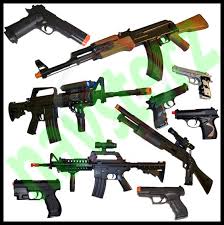 You’ll notice that the list includes all types of firearms: Rifles, shotguns and pistols. If you don’t know much about guns but would like an introduction to what types of firearms you might need for different scenarios, you can read this Introduction to Firearms that I wrote a while ago. Although you probably know what you’ll want to take (if you’re a gun owner), you may consider putting together a “Don’t Forget List” for firearms. Be sure to grab as many magazines and ammunition as you feel you need and don’t forget your gun cleaning kit.
You’ll notice that the list includes all types of firearms: Rifles, shotguns and pistols. If you don’t know much about guns but would like an introduction to what types of firearms you might need for different scenarios, you can read this Introduction to Firearms that I wrote a while ago. Although you probably know what you’ll want to take (if you’re a gun owner), you may consider putting together a “Don’t Forget List” for firearms. Be sure to grab as many magazines and ammunition as you feel you need and don’t forget your gun cleaning kit.
If you are inclined to prepare for a possible defensive situation, the other defensive items on this list will be useful for you. I personally include my Battle Vest as part of my 72 Hour Kit and have it pre-packed so I can grab it on the run.
Click here for our next segment continuing the category review. If you have anything to add about these categories, please do so in the comments!
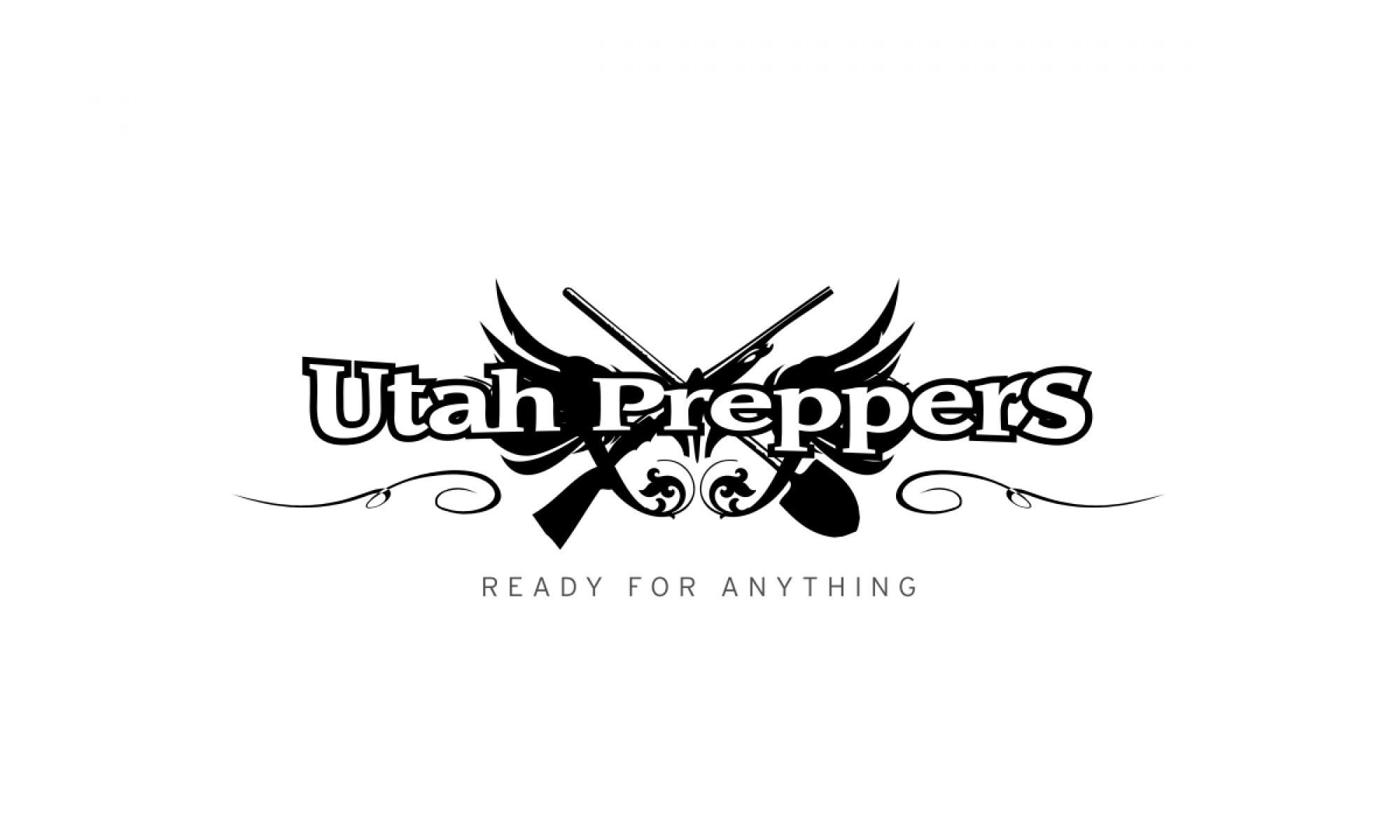

Great Post Phil. This would be good for Louisiana Preppers. Hurricane season is coming..
Great Post Phil. This would be good for Louisiana Preppers. Hurricane season is coming..